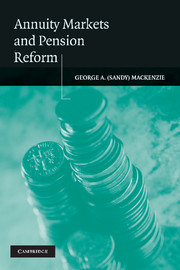Book contents
- Frontmatter
- Contents
- List of Tables
- Acknowledgments
- Introduction
- PART ONE
- 1 The Demand Side of the Annuity Market
- 2 The Supply Side of the Annuity Market
- 3 The Regulation of Annuity Providers
- 4 Experience with Individual Account Reforms
- PART TWO
- Appendix 1 The Economics and Financing of Annuities
- Appendix 2 Aging and Its Impact on Pension Systems
- Glosssary
- References
- Index
1 - The Demand Side of the Annuity Market
Published online by Cambridge University Press: 13 November 2009
- Frontmatter
- Contents
- List of Tables
- Acknowledgments
- Introduction
- PART ONE
- 1 The Demand Side of the Annuity Market
- 2 The Supply Side of the Annuity Market
- 3 The Regulation of Annuity Providers
- 4 Experience with Individual Account Reforms
- PART TWO
- Appendix 1 The Economics and Financing of Annuities
- Appendix 2 Aging and Its Impact on Pension Systems
- Glosssary
- References
- Index
Summary
INTRODUCTION
Annuities come in many shapes and sizes (see Table 1.1 for a taxonomy). They differ as regards the duration of the distribution phase, and as regards rights of survivorship – i.e. whether an annuity continues to be paid at some rate to a surviving spouse or some other party when the annuitant dies. Annuities also differ according to the timing and number of the premium payments made before distributions begin, and according to the form the distributions take (fixed or variable). Variable payment annuities may assume a number of forms, and may be classified according to whether the payment has a fixed component or not. Typically, it does. Annuities with a fixed payment may be further classified according to whether the payment is fixed in nominal or in real terms. The single premium immediate life annuity (SPIA) tells us by its name the timing and number of premium payments, the timing of the start of annuity payments, and the period over which they are paid. In addition, the SPIA is fixed in nominal terms, and may or may not have rights of survivorship.
The life annuity is not the only form of annuity – nor are annuities the only financial instrument – that can provide or contribute to a secure retirement. However, it is unique in providing insurance against the consequences of living an unexpectedly long life and either exhausting one's savings before life ends, or being obliged to live in privation to forestall that contingency.
- Type
- Chapter
- Information
- Annuity Markets and Pension Reform , pp. 21 - 57Publisher: Cambridge University PressPrint publication year: 2006



